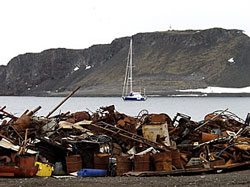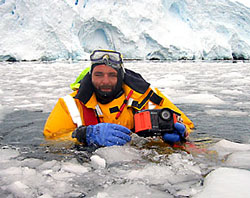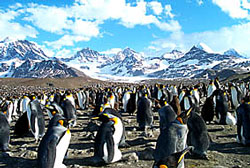The 2004 Travel Photographer of the Year competition opens for entries on February 22.
Following a successful first year in 2003, in which photographers from 34 countries submitted just under 10,000 images, this annual competition for amateur and professional photographers now features: four portfolio categories covering every aspect of travel photography; a Single Image category; a special Young Travel Photographer category; Student Awards and a remarkable £60,000 prize package.
Prizes include some travel and the very latest photographic equipment and software.
The photographer who demonstrates the greatest skill, diversity and creativity in two different portfolio categories will follow in the footsteps of 2003 winner Peter Adams, and earn the prestigious title of Travel Photographer of the Year and the satisfaction of being judged the very best travel photographer in 2004.
The winner and a companion will be able to take the photographic trip of a lifetime with their choice of a pair of round the world air tickets or two Business Class tickets to any one destination served by the Star Alliance network, the global network that brings together 14 of the world’s finest airlines. Added to this a £2,000 spending spree in a Calumet photographic store, plus Adobe CS Collection Premium and Video Collection software, to optimise the images they shoot on their travels.
Photographers aged 16 and under can submit four images on the theme ‘My World, My View’ which show what travel means to them. It’s free to enter and the prizes are fantastic. The winner receives a top of the range HP Pavilion Photosmart PC with integrated camera docking station and 6-1 memory card reader, plus a top-spec HP Photosmart digital camera, photo centric scanner and photo printer, a unique photography masterclass with renowned landscape photographer Charlie Waite, courtesy of Light & Land, and Adobe CS Collection Premium software.
The new 2004 competition categories are:
Peoples and Cultures Portfolio
This portfolio celebrates humanity in all its many guises, and the diversity that different cultures bring to the travel experience. Prize: the brand new, state-of-the-art Fujifilm S3 Pro digital camera and lens, a 22-day overland adventure for two through Kenya and Tanzania with Guerba, and Adobe CS Collection Standard software.
Essence of Travel Portfolio
This encompasses places, festivals, leisure, architecture, food, transport, tourism and history. Prize: the highly desirable new Hasselblad XPan II Pro panoramic camera; a 12-day fly/drive adventure for two people to explore Sweden with Discover the World, and Adobe CS Collection Standard software.
Spirit of Adventure Portfolio
This category allows entrants to capture the thrill of adventure – however large or small – that challenges the traveller. Prize: a once in a lifetime expedition for two people with Land Rover’s global conservation partner Biosphere Expeditions to the Tatra mountains in Slovakia; a custom-built website from web wizards Resolutions, and Adobe CS Collection Standard software. To prepare them for their expedition, the winner will also spend a day at one of Land Rover’s off-road driving centres.
Living Planet Portfolio
This encompasses landscape, the environment, and wildlife. Prize: the top-of-the-range Wacom Cintiq 18SX Interactive Pen Display with TFT monitor; a tour for two people around the stunning Galapagos Islands on board a motor yacht with G.A.P Adventures, and Adobe CS Collection Standard software.
‘Celebration’ – The Single Image Category
Entrants can submit one beautiful, uplifting image that captures the theme of ‘Celebration’ within the context of travel. Prize: a 10-day holiday for two to the photogenic Islands of the Bahamas, plus Adobe CS Collection Standard software.
Special Awards
Awards will be presented for the best three portfolio entries by students in full-time education, with the winners receiving leather print books from Plastic Sandwich, made in their choice of size and format and personalised with their names.
In addition, a number of special awards from Avery and Tribes Travel will be given for individual images nominated by the TPOTY panel of expert judges and the general public visiting the 2005 TPOTY exhibitions. Details will be announced later this year.
A chance to give something back
Another new element for TPOTY 2004 is the option to make a £1 charitable donation with the entry fee. The funds raised will be split between Tourism Concern and The Tribes Foundation. Tourism Concern is dedicated to campaigning for change in the world’s biggest industry – working to ensure holidays are as good for the people living in our holiday destinations as they are for us. The Tribes Foundation helps indigenous communities, preserves cultural heritage and ecological biodiversity in areas impacted by tourism outside the UK and encourages education in global cultural diversity within the UK.
Entry fees and closing dates
Photographers can enter as many categories as they like, as many times as they like. To compete for the title of Travel Photographer of the Year 2004 they must enter at least two different portfolio categories. The fee structure has been revised for 2004, making it more cost-effective to enter. Entry costs from just £5 for one portfolio category or up to four entries in the Single Image category, is completely free for under-17s and there is a discounted flat rate fee of £5 for students.
Entries are now open, and close on September 17, 2004. Full information and entry forms are available from www.tpoty.com or by sending a stamped addressed envelope to PO Box 2716, Maidenhead, Berkshire SL6 7ZN, England.

 Two areas demand to be visited. These are the old
part of the city at Ortygia, where the bus terminus was,
and the Parco Archeológico. I went down to Ortygia that
same evening, just too late for the tourist office opening
times, and enjoyed a brief stroll round and a good pizza.
It was quite good enough to call me back the next morning
but, other than getting the map and literature I wanted
from the tourist office, I was just a shade disappointed.
Ortygia is near enough an island and not a very big one; I
had not realised that the point, which should have given a
good sea view, was out of bounds to visitors because of the
requirements of the army. In general the area should
probably be regarded as a must see by anyone who has not
been to any of the beautiful old towns on the Italian
mainland but, unusually, I was as much struck by the
displayed poverty of some areas as anything. The cathedral
is very interesting, though scarcely beautiful, from the
outside with bits being part of an earlier Greek temple.
However, contrary to my usual view in southern Europe, the
interior, which contains some strikingly beautiful columns,
provides a better spectacle. Taken as a whole I preferred
Ortygia at night and the jury was still out on Siracusa as
I took a bus and then a walk to the entrance to the Parco
Archeológico.
Two areas demand to be visited. These are the old
part of the city at Ortygia, where the bus terminus was,
and the Parco Archeológico. I went down to Ortygia that
same evening, just too late for the tourist office opening
times, and enjoyed a brief stroll round and a good pizza.
It was quite good enough to call me back the next morning
but, other than getting the map and literature I wanted
from the tourist office, I was just a shade disappointed.
Ortygia is near enough an island and not a very big one; I
had not realised that the point, which should have given a
good sea view, was out of bounds to visitors because of the
requirements of the army. In general the area should
probably be regarded as a must see by anyone who has not
been to any of the beautiful old towns on the Italian
mainland but, unusually, I was as much struck by the
displayed poverty of some areas as anything. The cathedral
is very interesting, though scarcely beautiful, from the
outside with bits being part of an earlier Greek temple.
However, contrary to my usual view in southern Europe, the
interior, which contains some strikingly beautiful columns,
provides a better spectacle. Taken as a whole I preferred
Ortygia at night and the jury was still out on Siracusa as
I took a bus and then a walk to the entrance to the Parco
Archeológico. In 1992 Robert was the keynote speaker at the
first Earth Summit in Rio and spoke about the rubbish
problem in Antarctica. With their approval he then set up a
project to do something about it, choosing the Russian Base
of Bellingshausen, as it was one of the worse areas. Also,
it was accessible to visiting ships and had a runway
nearby, allowing both easy access for research into the
removal and aiding the difficult logistics.
In 1992 Robert was the keynote speaker at the
first Earth Summit in Rio and spoke about the rubbish
problem in Antarctica. With their approval he then set up a
project to do something about it, choosing the Russian Base
of Bellingshausen, as it was one of the worse areas. Also,
it was accessible to visiting ships and had a runway
nearby, allowing both easy access for research into the
removal and aiding the difficult logistics.
 South Georgia is truly one of the world’s
most spectacular wildlife habitats. This is mostly due to
its desolation and the fact that man finds it so very hard
to reach it – even in this day and age.
South Georgia is truly one of the world’s
most spectacular wildlife habitats. This is mostly due to
its desolation and the fact that man finds it so very hard
to reach it – even in this day and age.